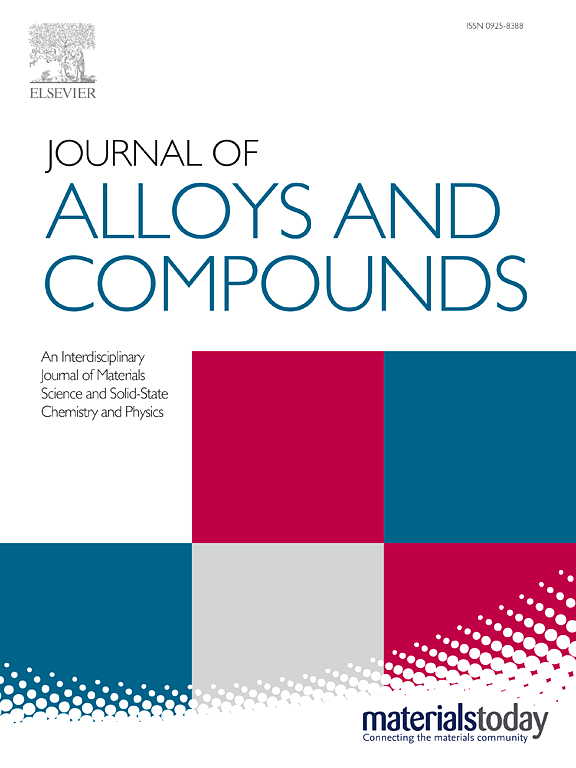高性能石榴石SrLu2Al3ScSiO12: Cr3+, Yb3+荧光粉的抗热猝灭和可调谐近红外发光
IF 5.8
2区 材料科学
Q2 CHEMISTRY, PHYSICAL
引用次数: 0
摘要
近红外(NIR)磷转换发光二极管(pc- led)在包括夜视、医疗诊断和植物照明在内的各个领域都有广泛的应用。然而,设计具有大半最大全宽(FWHM)和高热稳定性的近红外荧光粉仍然是一个挑战。本研究通过高温固相反应法制备了SrLu2Al3ScSiO12: Cr3+, Yb3+荧光粉(简称SLASSO: Cr3+, Yb3+)。SLASSO: Cr3+样品在蓝光区(~440 nm)和红光区(~600 nm)表现出两条较宽的吸收带,证实了其可以被蓝色LED芯片有效激发。通过精确控制Cr3+离子周围的晶体场环境,SLASSO: xCr3+荧光粉的发射光谱具有窄带到宽带的可调性,发射峰在705 ~ 807 nm范围内可调,FWHM在88 ~ 185 nm范围内可调。SLASSO: 2%Cr3+荧光粉具有高量子效率(75%)和优异的热稳定性(95%@423 K)。通过设计Cr3+和Yb3+之间的能量传递,SLASSO: 2%Cr3+, 1%Yb3+荧光粉实现了1000 nm以上的发光增强和零热猝灭(103%@423 K)。近红外pc-LED原型器件在300 mA下的输出功率为59.68 mW,在10 mA下的光电转换效率高达30.76%。这些结果突出了SrLu2Al3ScSiO12: Cr3+, Yb3+荧光粉在各种应用方面的潜力,包括无损检测,医疗诊断,防伪和夜视技术。本文章由计算机程序翻译,如有差异,请以英文原文为准。
Anti-Thermal Quenching and Tunable Near-Infrared Luminescence in High-Efficiency Garnet SrLu2Al3ScSiO12: Cr3+, Yb3+ Phosphors for Multifunctional Applications
Near-infrared (NIR) phosphor-converted light-emitting diodes (pc-LEDs) have found extensive applications in diverse fields including night vision, medical diagnostics, and plant lighting. However, designing NIR phosphors with large full width at half maximum (FWHM) and high thermal stability remains challenging. In this study, we developed a SrLu2Al3ScSiO12: Cr3+, Yb3+ phosphor (abbreviated as SLASSO: Cr3+, Yb3+) through a high-temperature solid-state reaction method. The SLASSO: Cr3+ samples exhibit two broad absorption bands in the blue light region (~440 nm) and red light region (~600 nm), confirming their can effective excitation by blue LED chips. Through precise control of the crystal field environment surrounding Cr3+ ions, the emission spectra of SLASSO: xCr3+ phosphors demonstrate tunability from narrow-band to broadband emission, with emission peaks adjustable from 705 nm to 807 nm and FWHM expandable from 88 nm to 185 nm. SLASSO: 2%Cr3+ phosphor demonstrates high quantum efficiency (75%) and excellent thermal stability (95%@423 K). By designing the energy transfer between Cr3+ and Yb3+, SLASSO: 2%Cr3+, 1%Yb3+ phosphors achieved both enhanced luminescence above 1000 nm and zero thermal quenching (103%@423 K). A prototype NIR pc-LED device demonstrated remarkable performance, achieving an output power of 59.68 mW at 300 mA and a high photoelectric conversion efficiency of 30.76% under 10 mA. These results highlight the SrLu2Al3ScSiO12: Cr3+, Yb3+ phosphor's potential for diverse applications, including non-destructive testing, medical diagnostics, anti-counterfeiting, and night vision technologies.
求助全文
通过发布文献求助,成功后即可免费获取论文全文。
去求助
来源期刊

Journal of Alloys and Compounds
工程技术-材料科学:综合
CiteScore
11.10
自引率
14.50%
发文量
5146
审稿时长
67 days
期刊介绍:
The Journal of Alloys and Compounds is intended to serve as an international medium for the publication of work on solid materials comprising compounds as well as alloys. Its great strength lies in the diversity of discipline which it encompasses, drawing together results from materials science, solid-state chemistry and physics.
 求助内容:
求助内容: 应助结果提醒方式:
应助结果提醒方式:


